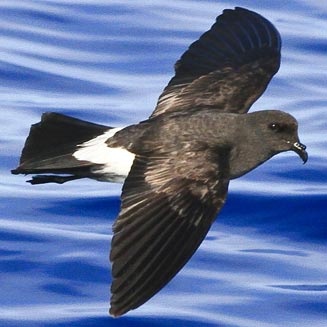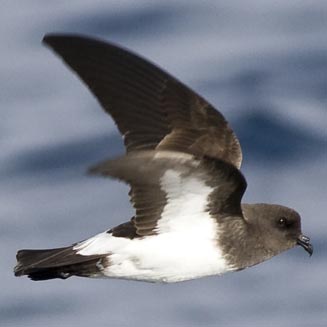|
Fregetta grallaria (White-bellied
storm-petrel)
Witpensstormswael [Afrikaans]; Witbuikstormvogeltje
[Dutch]; Océanite à ventre blanc [French]; Weißbauch-meeresläufer [German];
Painho-de-ventre-branco [Portuguese]
Life
> Eukaryotes >
Opisthokonta
> Metazoa (animals) >
Bilateria >
Deuterostomia > Chordata >
Craniata > Vertebrata (vertebrates) > Gnathostomata (jawed
vertebrates) > Teleostomi (teleost fish) > Osteichthyes (bony fish) > Class:
Sarcopterygii (lobe-finned
fish) > Stegocephalia (terrestrial
vertebrates) > Tetrapoda
(four-legged vertebrates) > Reptiliomorpha > Amniota >
Reptilia (reptiles) >
Romeriida > Diapsida > Archosauromorpha > Archosauria >
Dinosauria
(dinosaurs) > Saurischia > Theropoda (bipedal predatory dinosaurs) >
Coelurosauria > Maniraptora > Aves
(birds) > Order: Ciconiiformes
> Family: Hydrobatidae
 |
 |
|
White-bellied storm-petrels, near Ball's pyramid,
Lord Howe Island Marine Park, Pacific Ocean. [photo
Jack Shick
©] |
Distribution and habitat
Breeds on islands in the South Atlantic Ocean, South Indian
Ocean and South Pacific Ocean, dispersing in the non-breeding season to the
subtropics and occasionally the Northern Hemisphere, extending into southern
African waters below of 37° South, with occasional vagrant records along the
coast of South Africa and southern Namibia.
Movements and migrations
It is present at its breeding colonies from
September-May; it is mainly recorded in southern Africa outside of
this period.
Food
It mainly eats fish, squid, crustaceans, scraps and offal,
doing most of its foraging with other seabirds such as
Cory's shearwaters,
grabbing prey from the surface of the sea.
Threats
Not threatened, although it has been negatively effected by
the introduction of Black rats (Rattus rattus) at its Tristan da Cunha
colony.
References
-
Hockey PAR, Dean WRJ and Ryan PG 2005. Roberts
- Birds of southern Africa, VIIth ed. The Trustees of the John Voelcker
Bird Book Fund, Cape Town.
|
